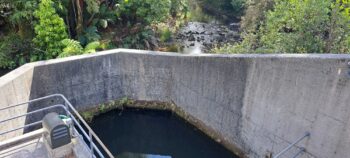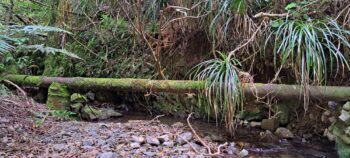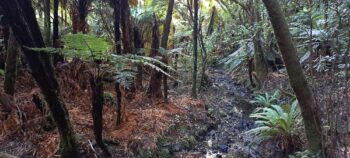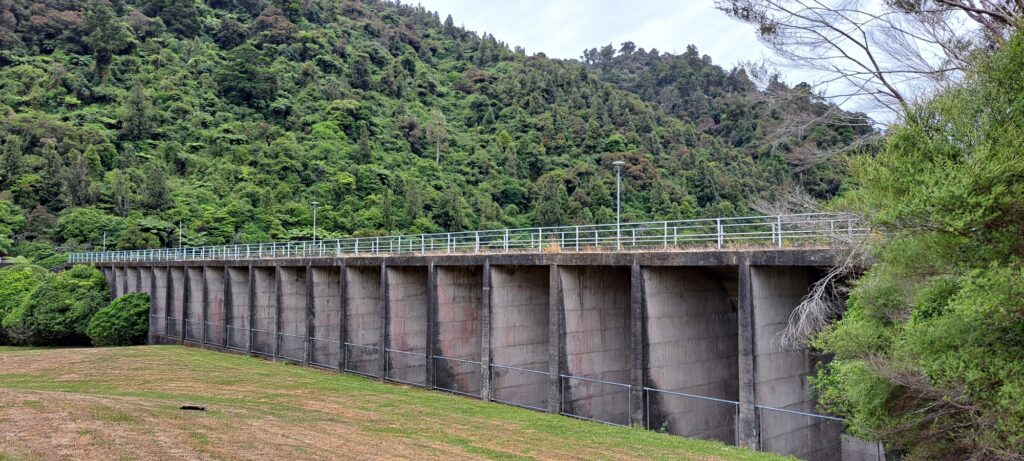Wainuiomata has had at least four different catchment areas with two still current today.
Wainuiomata holds significant historical relevance in water management. It formerly served as the primary catchment for supplying water to the Wellington region. Presently, it continues to provide 15-20% of the region’s water, albeit with a significant portion of the original infrastructure retired. Consequently, this decommissioning has opened up public access to the lower dam, which has since been transformed into a flourishing wetlands area.
It wasn’t just water for Wellington. Local catchments once provided Wainuiomata with water, until about the early 1960s. Even today, remnants from that period are still evident.
Wainuiomata / Orongorongo Water Supply Scheme
 With two catchment areas, this scheme got its start from an 1878 fire at the Wellington’s railway station. The lack of water to deal with the problem led to a search for a new water source in the Wellington region. The Wainuiomata Valley, adjacent to the Hutt Valley was chosen as the site for the water catchment followed by construction of an earth dam (known today as the Lower Dam) in 1878. Upon completion, it supplemented Wellington’s water supply along with the already existing catchment at Karori in the hills behind Wellington city.
With two catchment areas, this scheme got its start from an 1878 fire at the Wellington’s railway station. The lack of water to deal with the problem led to a search for a new water source in the Wellington region. The Wainuiomata Valley, adjacent to the Hutt Valley was chosen as the site for the water catchment followed by construction of an earth dam (known today as the Lower Dam) in 1878. Upon completion, it supplemented Wellington’s water supply along with the already existing catchment at Karori in the hills behind Wellington city.
By 1900, the city council sought solutions to enhance the water supply as water shortages became common. A larger dam proposed for Wainuiomata was rejected initially, but eventually accepted in 1904 after earthquakes, floods, and drought hit Wellington. The dam was completed in 1911, along with a second pipeline to Karori in 1912.
Population growth continued, with the driest years on record from 1915-17 nearly emptying the city’s reservoirs. Similar conditions in 1919 led the council to explore the Orongorongo Valley as a second water catchment in this scheme. Work began in 1921 to build weirs on the Orongorongo River and a tunnel linking the valleys, and a pipeline to Karori reservoir.
Skerretts Creek Water Catchment
 Skerretts Creek was Wainuiomata’s alternative to the Wellington Water supply from Morton Dam, operating briefly from the mid-1950s to the early 1960s. In the late 1950s, Hutt County Council took over the water supply, eventually connecting to the WCC pipeline for Morton Dam access. The Konini Reservoir’s creation later ensured a stable water source for Wainuiomata.
Skerretts Creek was Wainuiomata’s alternative to the Wellington Water supply from Morton Dam, operating briefly from the mid-1950s to the early 1960s. In the late 1950s, Hutt County Council took over the water supply, eventually connecting to the WCC pipeline for Morton Dam access. The Konini Reservoir’s creation later ensured a stable water source for Wainuiomata.
Hair Street Water Catchment (Wainuiomata Scenic Reserve)
 A water intake scheme was situated north of the Hair Street terminus. Built in the early 1940s, it discontinued operations by the early 1960s. No traces of the water intake scheme exist today. The area is now part of the Wainuiomata Scenic Reserve.
A water intake scheme was situated north of the Hair Street terminus. Built in the early 1940s, it discontinued operations by the early 1960s. No traces of the water intake scheme exist today. The area is now part of the Wainuiomata Scenic Reserve.


